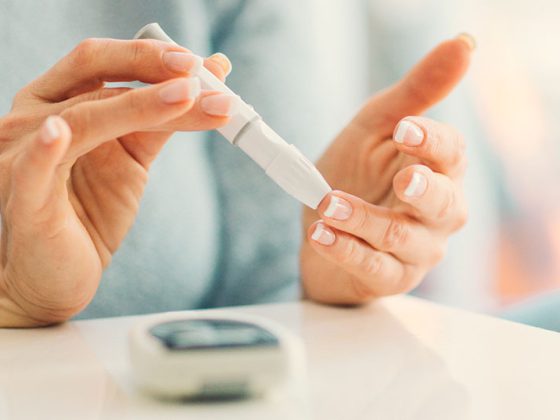A 48-year-old, severely obese patient is diagnosed with full-blown metabolic syndrome during an operative evaluation of osteoarthritis of the upper ankle. His arterial hypertension, dyslipidemia, hyperuricemia, grade III obesity, and type 2 diabetes mellitus must now be treated with a multifactorial therapeutic approach.
Background
A 48-year-old man presented for an operative evaluation of osteoarthritis of the upper right ankle. He had retrained from a manual job to a field service job after an occupational accident in the 1990s, which is why he now has to drive a lot and is affected accordingly by his arthritis. The patient suffered from arterial hypertension, dyslipidemia, grade III obesity (BMI 43 kg/m2), and hyperuricemia, which had already led to a gout attack. In addition, he had obstructive sleep apnea syndrome, for which a tonsillectomy had been performed previously and the patient received ventilation using CPAP therapy. During the operability assessment, a full-blown metabolic syndrome as defined by the International Diabetes Foundation in 2005 was also diagnosed. This means central obesity plus arterial hypertension, type 2 diabetes mellitus, and lowered HDL cholesterol.
Anamnesis and diagnostics
The physical examination revealed a weight of 120 kg with a height of 167 cm, which corresponds to a BMI of 43 kg/m2 and thus to grade III obesity according to the WHO classification. In addition, blood pressure was elevated at 134/84 mmHg and pulse at 96/min. Fasting blood glucose was 7.4 mmol/l and HbA1c value was 6.7%. Glomerular filtration rate was slightly decreased at 88 ml/min/1.73m2 according to the CKD-EPI formula, indicating incipient renal impairment. These rather unfavorable values are reinforced by the current professional and private lifestyle, as the patient is hardly physically active.
Therapy
Previous treatment focused on hypertension, dyslipidemia, and hyperuricemia. Perindopril/indapamide (10 mg/2.5 mg, 1-0-0) and bisoprolol (5 mg, ½-0-0) were given to treat hypertension. Furthermore, atorvastatin (40 mg, 1-0-0) was used for dyslipidemia and allopurinol (300 mg, 1-0-0) for hyperuricemia. Under atorvastatin, dyslipidemia with typically low HDL cholesterol showed normal total cholesterol. However, the LDL cholesterol target value, which is 1.8 mmol/l in diabetics <, was not quite reached. Hyperuricemia was well controlled on allopurinol.
In the face of massive obesity and newly discovered type 2 diabetes mellitus, the following changes in therapy were made: The SGLT-2 inhibitor canagliflozin in combination with metformin (Vokanamet®, 50 mg/850 mg, 1-0-1) and the GLP-1 receptor agonist dulaglutide (Trulicity® Prefilled pen, 0.75 mg s.c., 1 x weekly) prescribed for diabetes treatment. In addition, the bisoprolol dose was increased (5 mg, 0-0-1) and perindopril (10 mg, 1-0-0) was also given for hypertension. Atorvastatin and allopurinol treatment were maintained. New prescriptions included pantoprazole (40 mg, 1-0-0) for heartburn, vitamin D3 (12,000 units, 1 x weekly) for support in hypertension, and acemetacin in reserve for gout pain.
Treatment with dulaglutide had to be stopped after the first dose because of severe intolerance, especially nausea and urticarial edema. Subsequently, the dose of canagliflozin/metformin was increased (150 mg/850 mg, 1-0-1), but this had to be stopped because of new-onset nausea and diarrhea. However, these side effects were regressed after reduction of the metformin dose to 2 x 500 mg, so a switch to canagliflozin (Invokana®, 300 mg, 1-0-0) and metformin (500 mg, 1-0-1) was made.
In addition to drug treatment, lifestyle changes were recommended – especially a reduction in carbohydrates (pasta, rice and bread) and more exercise, if possible with the foot condition.
Present situation
The control after six months showed an improvement of all measured values. Thus, systolic and diastolic blood pressure were significantly lower at 122/80 mmHg (-11/-4 mmHg) and pulse at 64/min (-32/min). Improvements also occurred in fasting blood glucose at 5.3 mmol/l (-2.1 mmol/l), HbA1c at 5.6% (-1.1%), and eGFR at 93 ml/min/1.73m2 (+5 ml/min/1.73m2) compared with six months ago. In addition to the drug therapy, the patient had changed his lifestyle, now rides his bike once or twice a week for 1h and consciously reduces carbohydrates when eating. With these measures, the patient lost a total of 8.5 kg and now weighs 111.5 kg.
|
Author: PD Dr. Bernhard Hess, Specialist in Nephrology/Internal Medicine, Bellariastrasse 38, 8038 Zurich with editorial support from Dr. rer. nat. Christin Döring, IACULIS GmbH. Copyright and responsibility for the content of the patient case rests exclusively with the author.
| Do you also have an interesting diabetes case?
Then join us and submit a patient case! Our editorial team looks forward to receiving your e-mail at diabetescases@medizinonline.ch |












